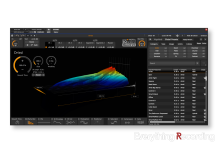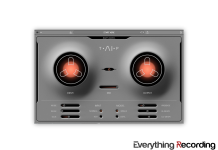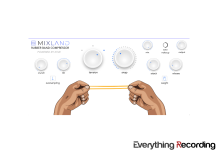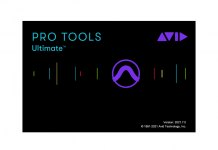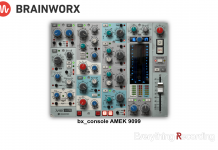- Any type of control is at your fingertips.
- Multiple modes make this compressor as versatile as they come.
- Would like more detection filters
- Could use an input level knob to drive compression harder.
More and more, the term “Compress for Tone” is popping up in training videos and forums. This is the practice where a dynamics tool is used for more than just a control to tame a transient track. Many vintage compressors have a tonal quality that will “color” the sound while treating audio. In EDM tracks, compression has been used for movement by sidechaining synths to a rhythmic element instead of the intended track. With all of the innovations in digital workstations, it almost seems like trailblazing unique uses of compression has run its course and there are no more worlds to conquer. Unfiltered Audio’s newest plugin Zip, takes on this very challenge.
Unfiltered Audio is a company part of the Plugin Alliance that takes normal tools and pushes them to limits unheard of. Their plugin lineup is a broad swath of tools from delays, distortion, to insane pitch bending effects. Everything Recording reviewed the latter of the 3 – Unfiltered Audio Fault (Review Here).
Zip’s interface follows the same design as other Unfiltered Audio plugins: both a dark and light skin of the GUI, resizable window, and a sleek minimalist look. If at first, controls seem daunting, simply hover over each control for tool tips. Each tip goes into user manual-like detail for specific controls, giving you an instant idea of how and why to turn the knobs. The settings menu enables / disables tool tips, as well as offers controls for changing the skin color and even allow for enabling a soft clip limiter to the output signal. This comes in handy when pushing the dynamics far beyond the limits of basic dynamics processing. The aforementioned sizing is also available in this menu in case the interface is too small.
Zip’s overall theme is all about handing control over to the user. On top of your standard functions like Threshold, Ratio, Attack, Release, Gain and Mix; Zip features deeper control of each of these experiences. While most compressors leave the minutiae tucked away under the hood, Zip places it right on the dashboard.
Sitting on the left-hand side of the interface is the heart of Zip. Herein lies Zip’s Analyzer section. A single graph conveniently displays incoming, compressed, and outgoing signal. The input displays in blue, output in pink, and dynamics in both white and red. Intensity of the input can be roughly monitored via the two dots in the Input box. This box also serves to change exactly where the audio for the analysis section comes from. This is set as default to the track, but can be easily set to another source. The RMS / PEAK control can change between a more easy-going response with RMS, or a faster response with PEAK.
Just to the right of the compression display is the Filter and Lookahead controls. The Filter at the 12 o’ clock position represents the audio coming into the analyzer as is. By turning counter-clockwise, a low pass filter is gradually added; turned clockwise, a high pass filter is applied. Values in the center of the knob display just what frequency is beginning the high or low passing. Unlike standard compressors, this filter can go as far as you want. To get a better picture of what is being sent to the Analysis section of the compressor, the Audition button will allow for an audible example. Combine this with the amplitude modes, and a whole world of possibilities open up.
The Lookahead does just what the name implies by delaying the audio and giving the Analysis section a sneak peek of what’s coming ahead of time. This ensures the fastest response for surgical transient control.
The “Amplitude” section is where zip starts separating from the pack. Instead of limiting the detector circuit down to basic choices, the doors get blown off. There are a total of six different modes, each with very unique tendencies. If you need the run of the mill compressor, amplitude mode analyzes the loudness of the signal, but that’s no fun – there are hundreds of plugins that accomplish this. Zip starts by going into the “upside down” with “Quietness”. This feature treats the quietest parts of the signal as the loudest. The compressor is then triggered more by quieter audio. The following two sections address frequency with either “Brightness” or “Darkness”. On Brightness, higher frequency content will trigger the compressor more and vice-versa with Darkness. The last two get a little more complex. “Noisiness” will measure frequency response and audio with faster changing frequencies will appear louder to analysis. Conversely, “Tonalness” responds more to stable or even frequency response. These modes open possibilities for compression in ways never even considered or even attainable in the analog world.
The right side of the GUI hosts the dynamics section, which contains both standard and unorthodox controls for handling audio. While the features of Threshold are pretty much unchangeable, Zip does add an Auto Threshold button which averages the incoming audio’s amplitude and nudges the value over the last few seconds of signal. This tailors the audio to a swath instead of just the “here and now” that a standard compressor uses. When the Auto Threshold button is active, the inner workings can be seen in the graphical section by the way of a dotted horizontal line. If the standard Threshold is used, this is represented by a solid horizontal line.
While the Expand, Ratio, Knee, Attack, and Release all work like other compressors, there are other functions in this section that can change how these stock controls behave and sound. The Envelope mode sits just under the attack and contains different reactionary circuits based on the compressor’s controls. Classic behaves like most, Goopy acts slowly and more vintage, Quick handles fast transients, and Extreme is… well quicker than Quick. Each of these modes offer a unique take on dynamics and give Zip an edge over most dynamics plugins on utility alone. No more digging through the stacks of plugins to get the characteristics needed for specific audio. This plugin can handle it all.
Zip even goes as far as incorporating what it calls Color Modes. These controls are at the very end of the signal chain and imparts different tonal effects to the already compressed signal. The perfect amount can be dialed in with the “Color” knob. From saturation and distortion (most likely borrowed from elements of their plugins Dent and Indent) to different filters, Zip can add subtle or outright sonic characteristics to the output. My personal favorite has become the Bitcrush, which adds a digital degrading effect to the audio. Used subtly and this adds an undertone of grit, pushed all the way and it will rip tracks apart like a chainsaw.
At the very end of the signal chain is the Mix knob, in-house Bypass button, Gain, and the AGC (Automatic Gain Compensation). AGC takes the Threshold, Ratio, and Analysis modes into consideration and applies a fixed amount of gain.
But that’s not all folks. Unfiltered audio applies their unique modulation system to Zip, giving the tool already able to produce movement, MORE movement. Dropping down the Modulation section gives a patch bay-like system where controls can be linked to different controls or even the actual control itself. While this can seem very intimidating at first, a little effort and reading the manual go a long way. The best way to learn is just to dive in and start patching controls. With functions like Input Followers, LFOs, Step Sequencers, there literally are infinite possibilities for creative effects inside Zip. The Modulator can even be connected to the ROLI Lightpad controller for live performance modes.
OK… With so many avenues of exploration let’s start with the impression of Zip just as a basic compressor. Honestly, when I first saw the tool, I thought of it more as a niche effect, a novelty, something that would work in unique creative circumstances. Sure, it’s very cool to be able to compress something utilizing quietness as loudness but in everyday situations, I wasn’t sure it would hold up. I could not have been more wrong. This Compressor redefines or maybe even surpasses being called a “Swiss Army Knife” tool. Zip can be used in almost any imaginable situation from transparent to transportive. The controls are as straight-forward as they come and results are easy to obtain. As a creative tool, none get better. If the modulation section intimidates, simply browse through their extremely comprehensive preset library. Something will catch your ear… guaranteed. If you want to dip your toe a little further, try to “Randomize Parameters” preset. Controls will go from “I never thought of that” to “That’s enough!”. Either way, creativity will flow.
While it is nearly impossible to critique a plugin like this or have any outright dislikes, I do have a few features I felt were missing. I mean, if we’re talking creative plugin, why not throw in the kitchen sink as well. Firstly, I would have liked to see an input gain control. If I’m already going to mangle audio, let me ream or “anti-ream” the Analysis section. Let me throw a modulator on the input and make it move harder using the AGC at the end to keep it level. I also would like to see color modes either pre or post compression. If I’m continuing deeper into the creative rabbit hole, let me have a controllable bandpass filter on the Analysis and Color mode. I want to dial in the exact section of frequencies I want triggering or give the audio a distorted megaphone sound. Lastly, I found myself using the “Color” section on its own without compression on tracks. I’d love to see a compact, one-knob style plugin of this one control with a mix knob, similarly to what they did with Dent and InDent.
Aside from the extra features this plugin inspired me to think up, Zip is the most impressive and creative tool I think I’ve seen yet. Zip is even to blame for how long this review took to publish. I kept recalling it in sessions to check features while writing and never came back to the review. The rabbit hole is deep with this one. If you are looking to eliminate the lists of plugins in your DAW, just get this one. You could take every other compressor out of my stash and even though I would miss a few, I could easily survive on Zip. Standing ovation, Unfiltered Audio. I don’t see how you possibly could keep pushing plugins further, but I am excited to see what’s next.





